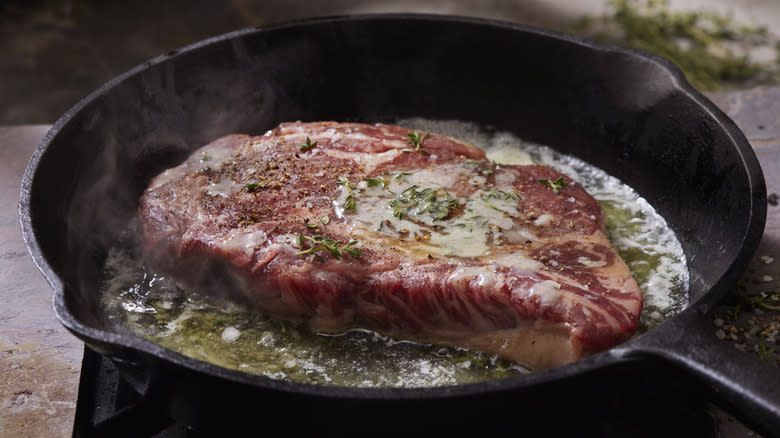Try The 2-Pan Method For Steak That's Juicy And Perfectly-Crusted Every Time

Has this ever happened to you: You get a pan screaming hot and slap in a steak to properly sear, only to remove it and find that a thinner cut, like skirt steak, is irreparably overcooked or a thick cut, like a bone-in ribeye, is practically raw inside? What if we told you, the fix to this burning problem was simply a pan -- or really, two pans -- away?
When it comes to cooking the perfect steak on the stovetop, the two-pan method stands out as a game-changer. This culinary technique ensures a mouthwatering sear on the outside while preserving the juiciness and tenderness within. The foundation of the two-pan method lies in achieving that coveted sear without sacrificing the steak's internal perfection.
Begin by preheating one pan over high heat until it reaches an extreme temperature. This searing pan is your ticket to locking in the steak's juices and creating a flavorful crust. Carefully place your seasoned steak onto the hot surface, and let it sizzle. The initial sear is quick -- just enough to develop a beautiful caramelized exterior. But here's where the magic happens: Transfer the steak to the second pan, heated over a low flame. This gentle heat ensures the steak continues cooking to the desired doneness without risking overcooking or burning, empowering home cooks to achieve restaurant-quality results with ease.
Read more: Your Guide To The Different Cuts Of Steak
Dual Heats Means More Control

Anyone who has gone questing for the precise methodology that will deliver the ideal steak at home knows there is no shortage of suggestions. The culinary world is teeming with innovative approaches to steak perfection, and the two-pan method is just the beginning. One notable alternative is the reverse sear, a method that flips the traditional searing process on its head.
In the reverse sear, the steak is first roasted or pan-fried at a moderate temperature to reach the desired doneness. Once cooked internally, it meets an extremely hot pan, grill, or broiler for a brief, intense sear. This technique delivers a uniform pink center and a mouthwateringly crisp crust, ensuring a symphony of textures and flavors in every bite. It is, clearly, a reversal of the 2-pan method, but one that works much the same.
Sous-vide cooking is the backbone of another popular dual-heat method. Here, steaks are vacuum-sealed and slow-cooked in a water bath to reach the desired temperature. Post-sous-vide, a quick sear, broil, or grill session imparts that irresistible outer char, marrying the best of both worlds -- precision and flavor.
These dual-heat methods provide home cooks with a versatile toolkit for crafting the perfect steak. Whether you choose the two-pan method for its simplicity or venture into the realms of reverse searing or sous-vide, mastering these techniques guarantees a steak experience that transcends the ordinary. Elevate your culinary skills and savor the joy of a perfectly cooked steak every time.
Read the original article on Tasting Table.


